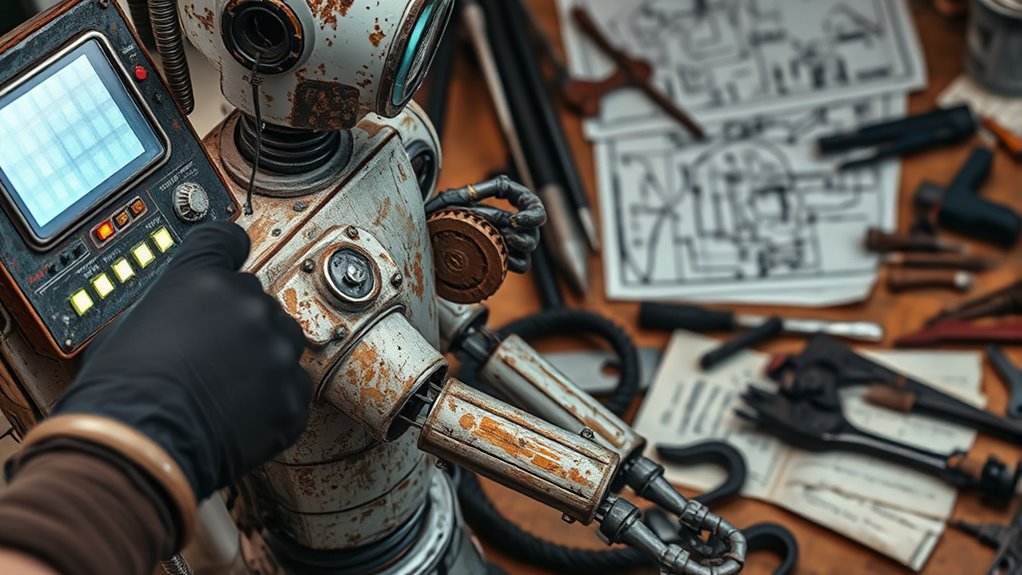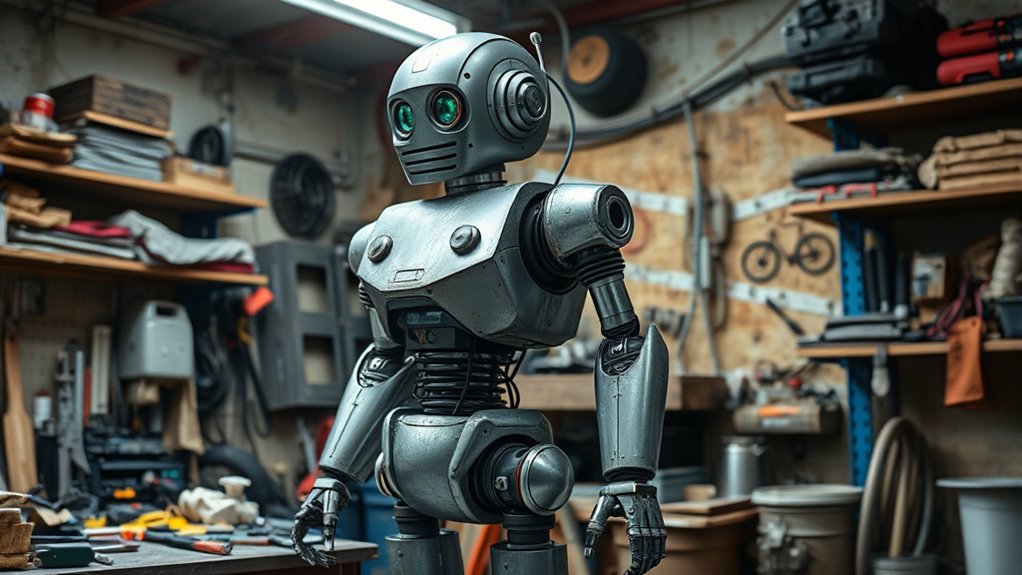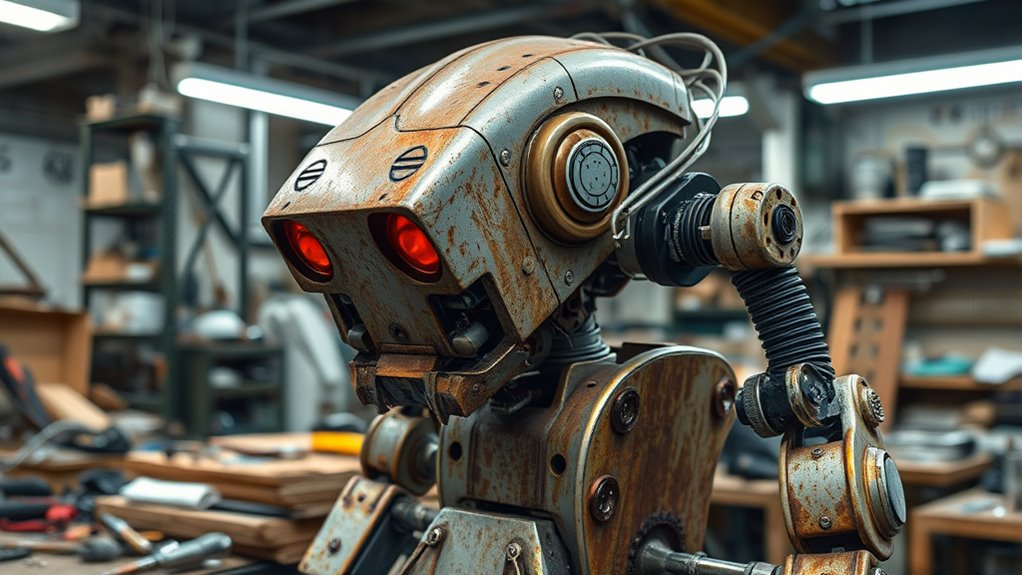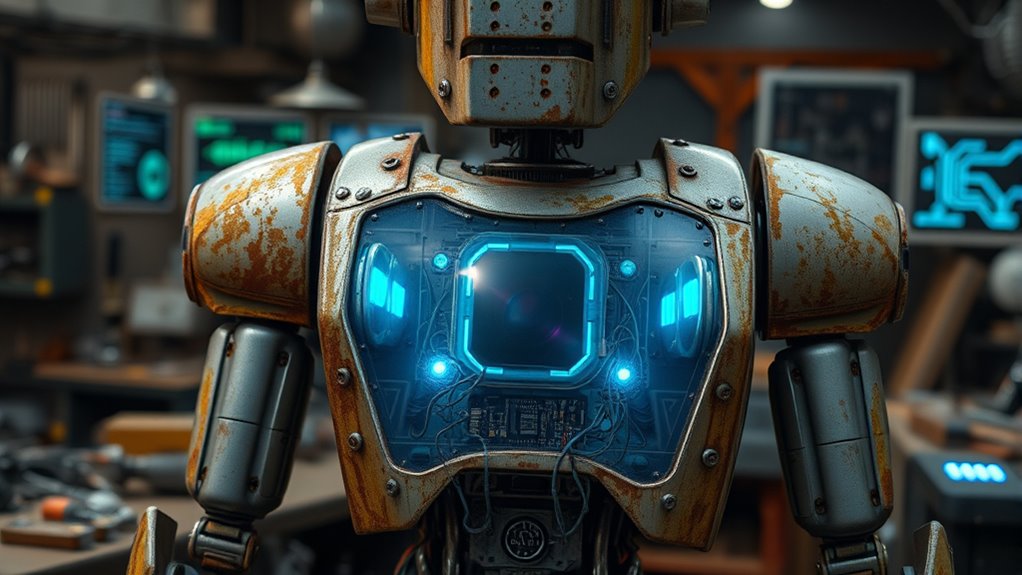To retrofit old robots for survival tasks, assess their current capabilities and identify limitations. Upgrade hardware with durable, weatherproof materials, and add sensors like LiDAR and multispectral cameras for environment awareness. Integrate AI for autonomous navigation and risk assessment, and enhance software with safety protocols and obstacle avoidance algorithms. Test thoroughly in simulated survival scenarios to fine-tune performance. Continue exploring these steps to learn how to transform your robot into a resilient survival asset.
Key Takeaways
- Assess existing hardware integrity and identify wear, corrosion, or damage requiring reinforcement or replacement.
- Upgrade sensors with ruggedized, environmentally resistant models for reliable outdoor navigation and hazard detection.
- Integrate advanced AI for autonomous navigation, risk assessment, and real-time decision-making tailored to survival scenarios.
- Enhance power systems with energy-efficient components and consider adding solar or energy harvesting solutions.
- Retrofit modular, weatherproof enclosures and protective coatings to improve durability against environmental stresses.
Assessing the Robot’s Current Capabilities and Limitations

To effectively retrofit an old robot for survival tasks, you first need to thoroughly assess its current capabilities and limitations. Begin by inspecting the mechanical and structural integrity, checking for wear, corrosion, or damage that could hinder performance. Evaluate the load-bearing capacity to confirm it can handle new operational demands and identify fatigue points that limit prolonged field use. Examine joints, actuators, and moving parts for responsiveness and range of motion. Verify the chassis materials can withstand environmental challenges like moisture, heat, or impacts. Next, review sensor and perception systems, noting sensor types, ranges, and reliability in outdoor conditions. Additionally, consider the durability of the materials and components to ensure long-term operation in harsh environments. This assessment aligns with AI in Business principles, ensuring that technological upgrades are both feasible and effective. Finally, analyze power supplies, energy management, mobility systems, and software to determine existing strengths and areas needing upgrades for survival scenarios. Conducting a comprehensive evaluation of system resilience helps identify vulnerabilities and prioritize necessary modifications. Furthermore, incorporating sensor robustness strategies can improve environmental adaptability and data accuracy. It is also important to evaluate the compatibility of new components with existing systems to prevent integration issues.
Identifying Survival-Specific Tasks and Requirements

Understanding the core survival tasks a robot must perform is essential for guiding effective retrofit strategies. You need to identify critical functions like autonomous navigation, where advanced sensors and mapping systems help handle tough terrains. Risk assessment AI will enable real-time danger evaluation, while upgraded communication modules ensure reliable data exchange in challenging environments.
Environmental adaptation capabilities allow your robot to perform amidst changing conditions, and efficient power management extends operational time in remote areas. To support these tasks, consider adding multispectral, acoustic, and chemical sensors for better awareness. Developing decision-making algorithms, path planning, and object recognition software will enhance autonomy.
Incorporate safety protocols like system redundancy and collision avoidance. By clearly defining these survival-specific requirements, you create a focused retrofit plan that boosts your robot’s resilience and effectiveness in survival scenarios.
Upgrading Hardware Components for Environmental Resilience

Upgrading hardware components is essential for enhancing your robot’s resilience against harsh environmental conditions. Start by selecting durable materials like biodegradable or recyclable options to reduce long-term environmental impact. Incorporate modular designs to simplify repairs and recycling, extending your robot’s lifespan. Weatherproof essential components with appropriate coatings and seals to withstand moisture, dust, and temperature extremes. Replace outdated parts with more robust alternatives to improve durability and performance. Vibration reduction strategies, such as damping mounts, help protect mechanical parts in demanding environments. Additionally, integrating efficient power management—like solar panels or energy harvesting devices—ensures sustained operation in remote areas. Considering material sustainability when upgrading components supports both durability and environmental responsibility. Understanding environmental resilience principles can guide you in selecting the most effective upgrades for challenging conditions. Employing robust component selection techniques further enhances your robot’s capacity to survive in extreme environments. Incorporating advanced testing methods can help verify that the upgrades meet the required standards for harsh conditions. Recognizing the importance of grocery savings strategies can also assist in optimizing resource allocation for maintenance and upgrades. These upgrades make your robot more resilient, adaptable, and capable of surviving tough conditions, ultimately increasing its effectiveness for survival tasks.
Integrating Sensors and AI for Autonomous Functionality

Integrating sensors and AI transforms your robot into a highly autonomous system capable of adapting to complex environments. With sensors like LiDAR, cameras, and proximity detectors, your robot gains precise spatial awareness, obstacle detection, and real-time feedback. Self Watering Plant Pots utilize similar reservoir systems that can be adapted for fluid management in robotic applications, providing insights into efficient resource handling. AI techniques such as machine learning and deep learning analyze sensor data to identify patterns, faults, and anomalies, enabling predictive maintenance and improved accuracy. Sensor fusion combines information from multiple sources, enhancing decision-making and navigation. This integration boosts performance, reduces errors, and allows your robot to operate efficiently without constant human oversight. Additionally, the use of robust data processing methods helps in maintaining data integrity under various operating conditions. Implementing comprehensive sensor calibration ensures data accuracy and reliability, which is crucial for complex tasks. While challenges like maintaining data consistency and hardware compatibility exist, choosing cost-effective sensors and implementing streamlined installation methods can help you overcome these hurdles. Furthermore, incorporating creative problem-solving approaches can lead to innovative solutions for hardware integration and system resilience. The result is a smarter, more resilient robot ready for survival tasks.
Modifying Software for Survival Operations and Safety Protocols

Modifying software for survival operations and safety protocols is vital to guarantee your robot can respond effectively in high-stakes environments. Start by implementing security upgrades to defend against cyber threats and assure data integrity. Develop task management systems that prioritize actions efficiently under pressure, and enhance real-time data processing to enable quick decisions during emergencies. Integrate communication protocols for coordination with other robots and human teams, and embed adaptive learning algorithms that let your robot learn from experiences and adapt to new challenges. Safety protocols are essential—include emergency shutdown procedures, automatic diagnostics, and obstacle navigation algorithms to prevent harm. Guarantee your software complies with safety standards and features reliable communication, safeguarding both the robot and its operators in survival scenarios. Additionally, incorporating high-pressure application techniques can improve the robot’s ability to handle demanding physical tasks safely and efficiently. Emphasizing vibrational resilience in your programming can further help your robot maintain stability and performance under extreme conditions. Incorporating AI-driven diagnostics can also ensure early detection of potential system failures, enhancing overall robustness. Furthermore, considering female-focused design principles might improve user interaction and safety features tailored to diverse operational environments.
Testing, Training, and Deploying the Retrofitted Robot in Survival Scenarios

Before deploying your retrofitted robot in survival scenarios, thorough testing is essential to guarantee it performs reliably under challenging conditions. Start by evaluating environmental compatibility—test the robot in various environments to confirm durability and functionality. Incorporating environmental resilience features can significantly improve the robot’s ability to handle unforeseen stresses during missions. Additionally, assessing the power management system ensures sustained operation during extended deployments, which is crucial in survival situations. To ensure optimal performance, it is also important to verify that the robot’s electrical systems are robust against environmental factors such as moisture and temperature fluctuations. Incorporating robust electrical systems can prevent common failures caused by environmental stressors.
Simulate survival tasks like traversing rubble or hazardous zones to assess its operational capabilities. Conduct sensitivity tests to identify how environmental stresses affect performance, and evaluate durability to ensure it withstands wear over time. Developing a comprehensive testing protocol helps identify potential failure points before real-world deployment.
Develop clear performance metrics to measure success in real-world situations. Once testing is complete, train the robot using customized scenarios that mimic actual challenges, focusing on adaptability and decision-making algorithms. Additionally, consider incorporating terrain adaptability features to enhance performance across different environments.
Finally, deploy the robot strategically, ensuring it integrates seamlessly with human teams, follows safety protocols, and maximizes its effectiveness in survival efforts.
Frequently Asked Questions
What Are the Most Cost-Effective Retrofitting Options for Survival Tasks?
You want to find the most cost-effective ways to retrofit robots for survival tasks. Focus on using affordable materials like aluminum and plastics, and modify existing robots instead of buying new ones.
Select essential components such as high-torque motors and durable parts, and perform in-house upgrades.
Prioritize features that improve performance and safety without overspending, ensuring your robots are reliable and ready for demanding survival environments.
How Can Retrofitting Extend a Robot’S Lifespan Beyond 15 Years?
To extend your robot’s lifespan beyond 15 years, you should focus on regular preventative maintenance like timely component replacements, software updates, and thorough cleaning.
Upgrading hardware with modern parts and integrating new technologies, such as AI or energy-efficient systems, also assists.
Managing spare parts efficiently through inventory and predictive maintenance guarantees quick repairs.
These steps keep your robot adaptable, reliable, and functional for years to come.
Which Sensors Are Best for Detecting Environmental Hazards in Survival Scenarios?
Think of sensors as the robot’s sixth sense, guiding it through danger’s fog. For survival, you’ll want soil sensors to spot contaminants, gas sensors to detect toxic fumes, and water sensors to find safe drinking sources.
Temperature, humidity, and air quality sensors act like an environmental compass, warning you of shifting conditions. Together, these sensors form a vigilant sentinel, turning an old robot into a guardian for life’s unpredictable twists.
How Do Retrofitting Costs Compare to Purchasing New Survival Robots?
When comparing retrofitting costs to buying new survival robots, you’ll find retrofitting usually has a lower initial expense, especially if you already own the equipment.
While new robots offer the latest tech and full support, retrofitting extends your current robot’s life, improves efficiency, and reduces overall costs over time.
Consider your specific needs and long-term goals to decide if investing in upgrades makes more sense than purchasing new units.
What Safety Regulations Apply to Retrofitted Robots in Disaster Zones?
Did you know that over 80% of robotic accidents happen due to non-compliance with safety standards?
When retrofitting robots for disaster zones, you must follow current safety regulations, including regional standards like CE marking and ISO standards, ensuring safety and reliability.
You also need to implement physical safety measures, train staff, and document changes thoroughly.
Failing to adhere could lead to legal liabilities and compromised safety during critical rescue operations.
Conclusion
By boldly bridging barriers, you breathe new life into aging robots, transforming them into resilient, reliable survival responders. With careful customization, clever coding, and consistent testing, you guarantee they’re prepared for unpredictable environments. This process proves that with ingenuity and initiative, old machines can overcome obstacles and offer invaluable aid in emergencies. So, take charge, innovate, and inspire, turning tired tech into tailored tools ready to tackle tomorrow’s trials today.










